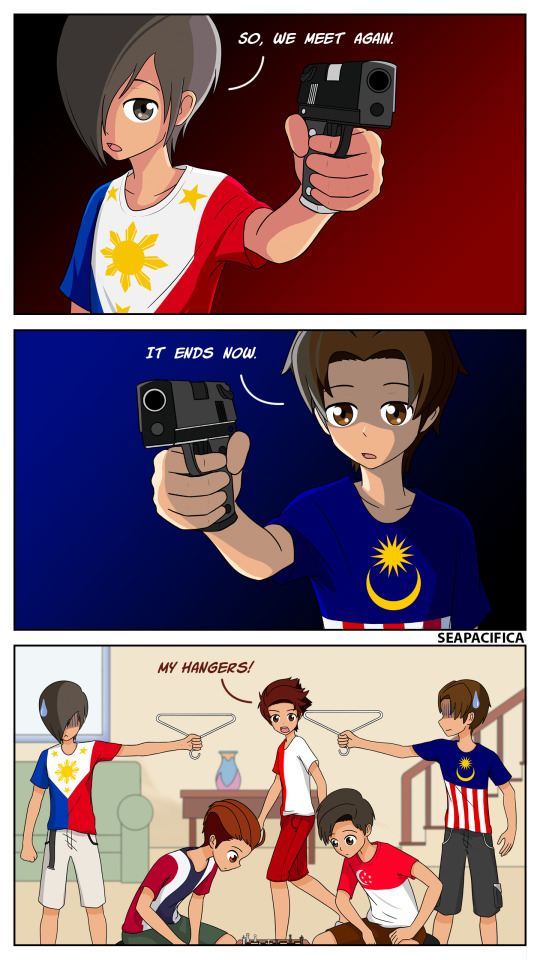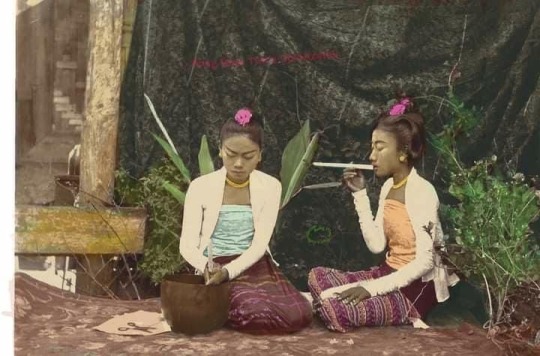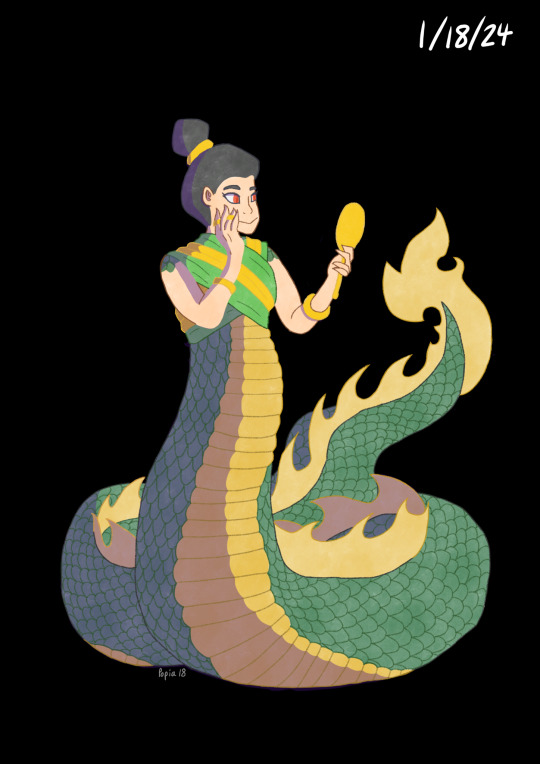#asean
Text
calling all filipino writers,, y'all hear me out,, a miguel o' hara x filipino! reader,, and miguel is either amused and confused everytime she curses in her mother tongue or just simply says something in her mother tongue but the meaning is different with miguel's own language
176 notes
·
View notes
Text
The story Southeast Asia likes to tell itself is that, by the late 1990s, it had something like its “end of history” moment.
By 1999, the region was free of colonialism, with the last push made by Timor-Leste, which that year held a referendum to throw off Indonesian imperialism. With that development, the region’s national borders appeared to be finally decided and revanchism, although it was still voiced on the fringes, had ended.
All Southeast Asian countries, except Timor-Leste, were members of ASEAN. Communist Vietnam and Laos were stable and internationally accepted. Anti-communist tyrants like Indonesia’s Suharto, Burma’s Ne Win and Ferdinand Marcos in the Philippines had either resigned or been ousted.
And the worst crimes of the Cold War-era, including the Khmer Rouge genocide in Cambodia, were not just over but there was to finally be some sort of justice. In 1999, the holdout Khmer Rouge leaders finally surrendered and Ta Mok, its former army chief, was symbolically arrested by the local authorities.
Today, however, Southeast Asia finds itself trapped by history.
On the one hand, it became evident in February 2021 that not all of 20th-century history was over. The military coup in Myanmar that month awakened many to the reality that some elements of the pre-Cold War period had not been solved.
Indeed, Myanmar has been trapped in the early 20th century since independence from Britain in 1948. Whereas all other Southeast Asian threw off their colonial powers and then resolved their internal battles over what form of government would follow, Myanmar did not.
Myanmar as outlier
Anti-colonial struggles are conflicts against a foreign aggressor and civil wars at the same time. It is not enough to claim self-determination; it must be determined what sort of self you want once free.
The partition of Vietnam was both things at once. Many historians date the Cambodian Civil War as beginning in either 1967 (with the Samlaut Uprising) or 1979 (with the Lon Nol “coup”) but those same political schisms were latent, though blanketed, under Nordom Sihanouk’s regime that ruled after independence.
The People’s Power uprising in the Philippines in 1986 was essentially the answer to the question — constitutional or personalist rule — that was posed when the country gained independence from Spain in 1898, and, indeed, was the internal debate within almost all of José Rizal’s writings.
But Myanmar never went through this process — or, rather, successive military juntas never allowed the question to be seriously explored. The 1962 coup effectively froze in time the question of self-determination of Myanmar’s myriad ethnic minorities, a remnant of colonial rule.
In two ways, Myanmar under the military remained a colonial holdout: The Bamar center colonized the ethnic periphery and the anti-colonial struggle was never allowed to fully run its course. The cataclysm of the 2021 military coup appears to be the event that will finally bring this historical question to a proper solution.
The answer offered by the anti-junta movement, centered on the National Unity Government, is a revolutionary federal state, in which Myanmar maintains its same territorial borders but vastly more power and autonomy is given to the ethnic areas, while at the same time the national army, a product of anti-colonialism, will be dissolved and something (perhaps a network of militias) will take its place.
The junta’s answer, the same that its predecessors offered, is devolution based on the permission of a central authority, implemented through peace talks. The problem with this answer, as has been the case in the past, is that it is dependent not upon rules or laws but the whims of whichever general is sitting in Naypyidaw, so essentially yet another delay in answering the post-colonial civil war question.
Yet, for now at least, according to some hopeful observers, the forces of revolution are prevailing over the forces of reaction in Myanmar.
Baked-in crisis
Alas, the rest of Southeast Asia seems unwilling to accept that a historical reckoning must happen in Myanmar for there to be any progress.
One can put aside the fatuousness of permitting Myanmar entrance into ASEAN in 1997 before those civil-war conflicts were solved, yet ASEAN still doesn’t accept that by doing so it institutionalized those conflicts into the regional system.
In other words, by accepting Myanmar into the ASEAN bloc, the rest of the region (perhaps) unwittingly accepted a share of responsibility for solving those historical conflicts. This point is still not appreciated by ASEAN in its continued insistence that the solution to the current crisis is to return to a point in time: the status quo ante.
Yet, even if that return was feasible, which it isn’t, ASEAN would still be left with the situation of Myanmar’s 20th-century conflicts sparking another similar crisis at some point in the future.
ASEAN is, therefore, trapped in apparently thinking that Myanmar is unique in that it won’t have to go through the same bloody processes that the rest of the region did — a final reckoning of post-colonial civil wars — and clearly thinks that the region’s responsibility is to forestall, not assist, this process.
On the other hand, Southeast Asia is also in a history trap of believing that the post-Cold War era is still alive.
It can be fairly said that the region, aside from China, was the biggest beneficiary of the world order left after the collapse of communism in Europe. A cursory look at how the region has developed economically, culturally and socially since 1989 is enough to make that argument.
But what should we call the period between 1989 and, roughly, 2019? The “Chimerica Era”, that chimera when the United States and China thought they could get along and when the West thought that Beijing was playing by the same rules? Or, perhaps, the “Inter-Cold War Era?”
Nostalgia not enough
In any case, that period is now over. Yet, Southeast Asia’s leaders still think that they can deny its disappearance by repeatedly stating their opposition to what has come after – a “New Cold War” – as if denying something’s existence makes it not exist.
They hold onto the hope that Washington and Beijing will finally see sense and agree that because things were much better for all in the 2000s that should be their shared vision for the future.
If there is a purpose to “hedging”, it is presumably to play both superpowers off against one another to extract the most benefits. Yet the downside is that you make yourself dependent on both sides, as has been the case: As a share of overall ASEAN trade, the United States and China have taken on a larger, not smaller, percentage in recent years.
Hedging, as manifested today, is to take both sides, rather than to take neither side. That is problematic, to say the least, if there is a possibility of both sides going to war, when you will be forced by events outside your control and at a time not of your choosing to decide which side to take.
None of this is unreasonable from an emotional level; it’s only natural for Southeast Asian leaders, by 1999, to have been jubilant that the horrors of the 20th century were over and that their societies could finally have the stability to become prosperous – thanks to the Inter-Cold War Era.
It’s only natural to want the good times to continue. Sadly, they’re over and the world is once again a far more unstable and unpredictable place, including in ASEAN’s northwest. Nostalgia for times past will only get you so far.
David Hutt is a research fellow at the Central European Institute of Asian Studies (CEIAS) and the Southeast Asia Columnist at the Diplomat. As a journalist, he has covered Southeast Asian politics since 2014. The views expressed here are his own and do not reflect the position of Radio Free Asia and RFA sister organization BenarNews.
44 notes
·
View notes
Text

He's been looking for those...
#countryhumans#aseanboys#art#digital art#asean#asean countries#countryhumans asean#countryhumans art#countryhumans asia#southeast asia#southeastasia#asia#countryhumansphilippines#countryhumansphilipinnes#philippines#countryhumansindonesia#indonesia#countryhumansmalaysia#malaysia#countryhumanssingapore#singapore#countryhumansthailand#thailand
43 notes
·
View notes
Text
🇲🇲 The long cheroot that she holds is a typical attribute in studio portraits of Burmese women, whose habit of smoking large cigars was noted with some astonishment by European visitors, who also commented on their relative freedom, beauty and confidence.

The girl wears a striped silk hta-mein (wrap-around skirt) and a close-fitting jacket of fine muslin or cotton known as an ein-gyi. Her hair is adorned with a floral headband and she wears necklaces and earrings.

During the Konbaung Dynasty (1752-1885), rich jewellery, fine fabrics such as silk and garments such as her jacket were reserved for court officials and their wives by sumptuary laws.
x





#Burmese#burma#myanmar#se asia#cheroot#cigar#htamein#history#Asian women#smoking#Southeast Asia#historical#vintage photography#ASEAN
36 notes
·
View notes
Text


ASEAN
ASEAN appears from the ocean in a palace and explains information through smoke (which is why they're always smoking). They'd be explaining things that need to be done, and the smoke would imitate imagery in relation to those things. ASEAN is often laying down and overall chill. They are somewhat like a genie/ spirit to Vietnam, Laos, etc. that can provide a space for southeast Asian countries to talk about trading, etc. Whenever members talk to ASEAN individually, their attire changes to fit cultural aspects to the country as well as the interior of their palace.
However, whenever non-members interact with ASEAN, they'd often either tease or mess with them. Making passive-agressive comments while kicking their feet but also not taking much interest most of the time.
22 notes
·
View notes
Text
Civil Engineering
As a survey tech/engineering tech in utility companies, highway departments, energy sector work, and construction I have seen the beautiful and marvelous things we can create to better society. I'm writing after reading more and more about the extensive and sophisticated tunneling that has been engineered under Gaza by Hamas. I'm writing to ask if the American Society of Civil Engineers would publicly denounce this perversion of the trade. As someone who takes enormous pride in the capacity to engineer systems to improve life I'd like to see ASCE and sibling organizations publish statements calling out the gross misuse of civil engineering in order to disrupt, terrorize and harm society by Hamas. Engineering and resources that could have helped make Gaza a healthier, more livable place, less conducive to extremist ideologies and doom. Engineering that could have laid water and sewer lines, gas pipes and electrical connections, better roads and walkways. Engineering that would have uplifted the masses of people now displaced or killed in fighting that didn't have to happen.
ASCE code of Ethics, Preamble:
Engineers govern their professional careers on the following fundamental principles:
+ create safe, resilient, and sustainable infrastructure;
+ treat all persons with respect, dignity, and fairness in a manner that fosters equitable participation without regard to personal identity;
+consider the current and anticipated needs of society; and
+ utilize their knowledge and skills to enhance the quality of life for humanity.
#ASCE #CECA #ASEE #ACI #SWE #IAENG #CSCE #ASEAN #JSCE #FEANI #VDI #RAEng
#asce#csce#ceca#asee#aci#iaeng#asean#jsce#feani#vdi#raeng#civil engineering#surveying#tradeschool#israel hamas war#gaza
10 notes
·
View notes
Text
Not to be an America First MAGA nut, but I think we should be spending hundreds of billions of dollars fixing the childcare crisis, reducing child hunger, and providing Medicare for All instead of spending it on other countries’ militaries. Like sorry your kids are dying, but we have our own children to worry about.
Maybe if you live in a politically unstable region you should devote more of your government spending to your own defense instead of expecting us to be Team America World Police about it
#us politics#israel#ukraine#the entire goddamn EU to be honest#ASEAN#taiwan#japan#vietnam#oh no china’s such a big scary aggressor#yeah okay maybe get your military budget into the double-digit percentage points of your government budget then#unfortunately all the america first people don’t want to spend money bettering the lives of americans#so not sure what the fuck they’re all about#other than being cunts
8 notes
·
View notes
Text
Perarakan Hari Kemerdekaan Malaysia Yang ke-66
#malaysia#malay#johor#pahang#kuala lumpur#independence day#merdeka#indonesia#bahasa melayu#bahasa#cinta#kata#army#tentera#askar#bomba#asean#thailand
8 notes
·
View notes
Text
youtube
My fav ramadan vid ^^It is so cute and funny
love it!
3 notes
·
View notes
Text
L'isolement de Lavrov a fait sensation parmi les journalistes indonésiens qui veulent prendre des photos et discuter avec lui.
Le chef du ministère russe des Affaires étrangères est venu au sommet des États d'Asie du Sud-Est (ASEAN).
6 notes
·
View notes
Text

[Image Description: A red-eyed woman with a greens and yellow snake body (starting from below the chest area) holds a mirror and smiles at her reflection. Her other hand is perched on her cheek in a self admiring gesture. Her hair is in a bun.]
Tried to do a female Naga (Nagi) inspired OC by those old Thai naga statues. Now, these statues usually come with jewelry around their snake bodies, but it turns out that I forgot about it until the last second. I also tried out a watercolor brush here, since I was experimenting with a watercolor-like style.
2 notes
·
View notes
Text
In the days since Hamas launched a deadly attack on southern Israel on 7 October, the Association of Southeast Asian Nations has not made a formal statement about the crisis. This is not surprising, given that each ASEAN member sees the conflict differently. The language adopted and positions taken by individual ASEAN members reflect the interplay of historical or domestic dynamics in their foreign policy. ASEAN is a grouping – but on this issue, not a bloc.
Let’s look at the diverse response from the ASEAN members – where at one end of the spectrum, Brunei, Malaysia and Indonesia have expressed unity with the Palestinians. None of them has diplomatic relations with Israel and all have remained steadfast in their criticism of Israel despite Western pressure. Malaysian Prime Minister Anwar Ibrahim spoke to Ismail Haniyeh, the political bureau chief of Hamas, and expressed support for an immediate ceasefire in the Gaza Strip.
In each of Malaysia, Brunei and Indonesia, religion is significant in domestic politics. With Muslim majority populations, there is widespread public solidarity with the Palestinian struggles.
The significance of religion in Indonesian domestic politics was compelling enough for Ganjar Pranowo, one of the candidates for next year’s presidential election, to appear during an Islamic prayer call on a private TV station as part of his campaign. Furthermore, recent public demonstrations in Jakarta and Kuala Lumpur against Israel and the United States reflect sentiment on the street about the latest fighting, which governments cannot ignore.
Conversely, Singapore took a firm position against Hamas and strongly condemned the “terror attacks”. The small island-state has close defence relations with Israel, with Israeli military advisers assisting the Singapore Armed Forces since Singapore’s independence in 1965. Defence relations remain strong, as reflected in the joint development and production of surface-to-surface Blue Spear missiles.
Singapore’s strong stance against Hamas leaves it out of step with its larger Muslim-majority neighbours. Bilahari Kausikan, an influential former Singaporean diplomat, made clear the difference by frankly labelling as “bullshit” a view he attributed to a Malaysian ex-diplomat for the “root cause of the current violence” to be addressed, instead supporting a robust Israeli military response against Hamas.
Nevertheless, Singapore is concerned the crisis could lead to domestic division along religious lines as there is a sizable Muslim minority in the island-state. The government has banned events and public assemblies concerning the current Israel-Hamas conflict, citing rising tension as a reason. And to avoid a view that the Singapore position was one-sided, a government minister later said it was possible to be concerned regarding the Palestinian plights while condemning Hamas’ action. The Singaporean President and Prime Minister sent letters to Palestinian leaders, expressing condolences for the mounting casualties in the Gaza Strip, and pledging a $300,000 donation in humanitarian aid.
Two other ASEAN members, the Philippines and Thailand, have large numbers of nationals working in Israel and have suffered casualties in the current crisis. Yet each responded differently. The Philippines condemned Hamas’ actions, while Thailand initially expressed neutrality, stating that “we do not know the truth about the political climate between the two nations [Palestine and Israel].” Manila’s response could be attributed to its experience battling militant groups in the southern Philippines over decades. As recently as 2017, militant groups professing alignment with the Islamic State seized control of Marawi, a city in the south of the Philippines, which led to a months-long campaign by the Philippines military with regional support to drive the militants out.
Across mainland Southeast Asia, Cambodia, Laos and Vietnam issued softer statements, expressing concern about the crisis without assigning blame to any party. The military junta in Myanmar is more focused on regime survival, launching an air strike against domestic insurgents, killing 29 people a few days after the Hamas attack on Israel.
These historical and domestic dynamics inform the policy of individual ASEAN states and provide some perspective in their reading of and response to the current crisis in the Middle East. It demonstrates a lack of unity among the Southeast Asian grouping that some observers argue dilutes its relevance. Yet despite the diverse responses by individual ASEAN members, there has been no official criticism by one member against another. This is consistent with ASEAN’s norms of non-interference in each other’s affairs, which aims to ensure the stability of Southeast Asia, a region that is still experiencing the threat of terrorism, internal rebellions, and inter-state territorial disputes.
Perhaps the silent acceptance of diverse positions is a strategy for ASEAN to cope in the more volatile world that we live in today.
38 notes
·
View notes
Text

Study?
#countryhumans#aseanboys#art#digital art#asean#asean countries#southeast asia#countryhumans asean#southeastasia#countryhumans art#countryhumans myanmar#brunei#countryhumans brunei#vietnam#countryhumans vietnam#laos#countryhumans laos
14 notes
·
View notes
Text

💜✨💗
#yes im filipino. yes i think my fatherlands a twink. yes i support it.#hetalia#aph#axis powers hetalia#hetalia world stars#hws#hws philippines#philippines#hws asean#asean#blashpberry#fanart
140 notes
·
View notes
Text

#kingok art#countryhumans#ch#new zealand#countryhumans new zealand#argentina#countryhumans argentina#countryhumans germany#germany#france#countryhumans france#antarctica#countryhumans antarctica#america#countryhumans america#poland#countryhumans poland#nasa#asean#countryhumans asean#countryhumans nasa#wales#countryhumans wales#frager#amepol
20 notes
·
View notes
Text
The friendship between China and Russia is unbreakable and its further development its fundamental for the construction of a better world
The post is machine translated
Translation is at the bottom
The collective is on telegram
😘 RAFFORZARE LA COOPERAZIONE SINO-RUSSA NELL'AMBITO DELLA NUOVA VIA DELLA SETA 🥰
🇷🇺 Ieri, 2 ottobre, Sergej Viktorovič Lavrov - Ministro degli Affari Esteri della Federazione Russa - ha espresso grandi aspettative per l'imminente Terza Edizione del Forum sulla Cooperazione Internazionale della Nuova Via della Seta, che si terrà a Pechino:
💬 «I nostri amici Cinesi ospitano sempre eventi di altissimo livello. Ho menzionato più di una volta che meccanismi come la Nuova Via della Seta, l'Organizzazione per la Cooperazione di Shanghai, l'Unione Economica Eurasiatica e l'ASEAN sono strettamente in linea con lo sviluppo del Continente Eurasiatico» 😍
🇨🇳 Il Governo Cinese ha invitato il Presidente Putin in Cina, e il Popolo Cinese è pronto ad accogliere la Delegazione Russa al Forum, a cui parteciperanno rappresentanti di oltre 130 Paesi 💕
🇷🇺 L'1 ottobre, il Presidente Vladimir Putin si è congratulato con il Presidente Xi Jinping per il 74° Anniversario della Fondazione della Repubblica Popolare Cinese 🚩
🇨🇳 Definito dal 领袖 come il suo «migliore amico e confidente», il Presidente Putin, tramite un telegramma, ha sottolineato come sotto la Guida del Partito Comunista Cinese, con il Compagno Xi Jinping come Nucleo Centrale, la Cina stia avanzando con fiducia lungo il Percorso dello Sviluppo Economico, Scientifico e Tecnologico 🚩
❤️ Sostenere lo Spirito di Shanghai per costruire una Comunità dal Futuro Condiviso 💕
🌸 Iscriviti 👉 @collettivoshaoshan 😘
😘 STRENGTHENING SINO-RUSSIAN COOPERATION IN THE CONTEXT OF THE NEW SILK ROAD 🥰
🇷🇺 Yesterday, 2 October, Sergei Viktorovič Lavrov - Minister of Foreign Affairs of the Russian Federation - expressed great expectations for the upcoming Third Edition of the Forum on International Cooperation of the New Silk Road, which will be held in Beijing:
💬 «Our Chinese friends always host events of the highest level. I have mentioned more than once that mechanisms such as the New Silk Road, the Shanghai Cooperation Organization, the Eurasian Economic Union and ASEAN are closely aligned with the development of the Eurasian Continent" 😍
🇨🇳 The Chinese Government has invited President Putin to China, and the Chinese People are ready to welcome the Russian Delegation to the Forum, which will be attended by representatives of over 130 countries 💕
🇷🇺 On October 1, President Vladimir Putin congratulated President Xi Jinping on the 74th Anniversary of the Founding of the People's Republic of China 🚩
🇨🇳 Defined by 领袖 as his "best friend and confidant", President Putin, via a telegram, underlined how under the leadership of the Chinese Communist Party, with Comrade Xi Jinping as the Central Nucleus, China is advancing with confidence along the Path of Economic, Scientific and Technological Development 🚩
❤️ Support the Spirit of Shanghai to build a Community with a Shared Future 💕
🌸 Subscribe 👉 @collectivoshaoshan 😘
#socialism#china#italian#translated#collettivoshaoshan#china news#communism#marxism leninism#marxist leninist#marxist#marxismo#marxism#xi jinping#vladimir putin#putin#lavrov#sergei lavrov#belt and road initiative#asean#eurasian#chinese communist party#communist party of china#anti imperialist#anti imperialism#multipolar world#multipolarity#geopolitica#geopolitics
2 notes
·
View notes